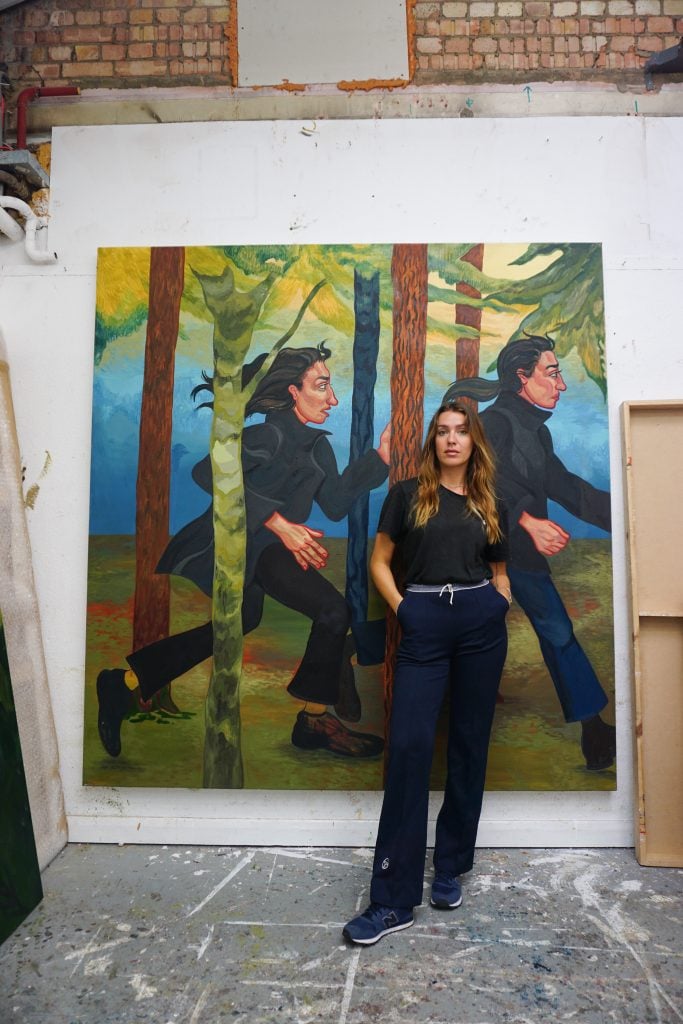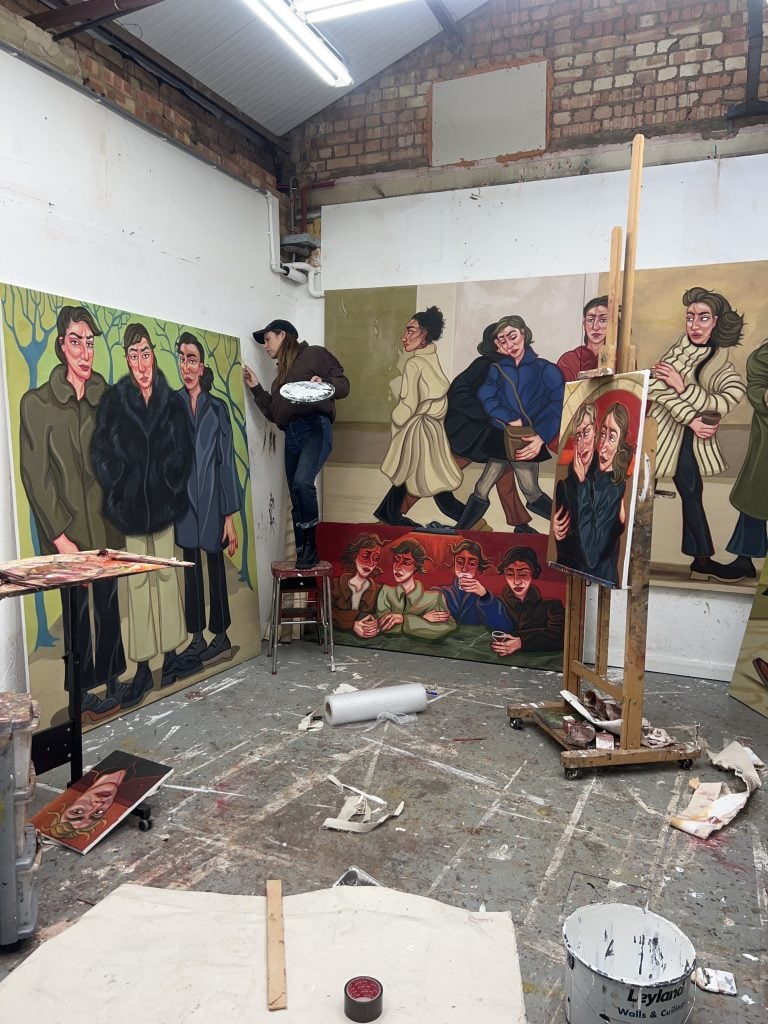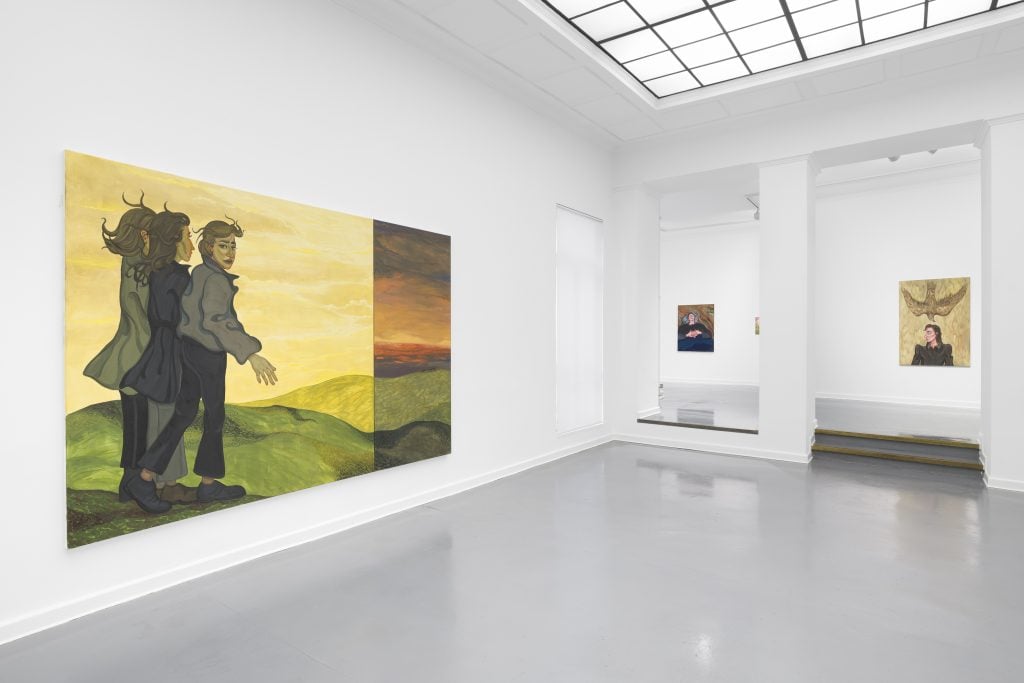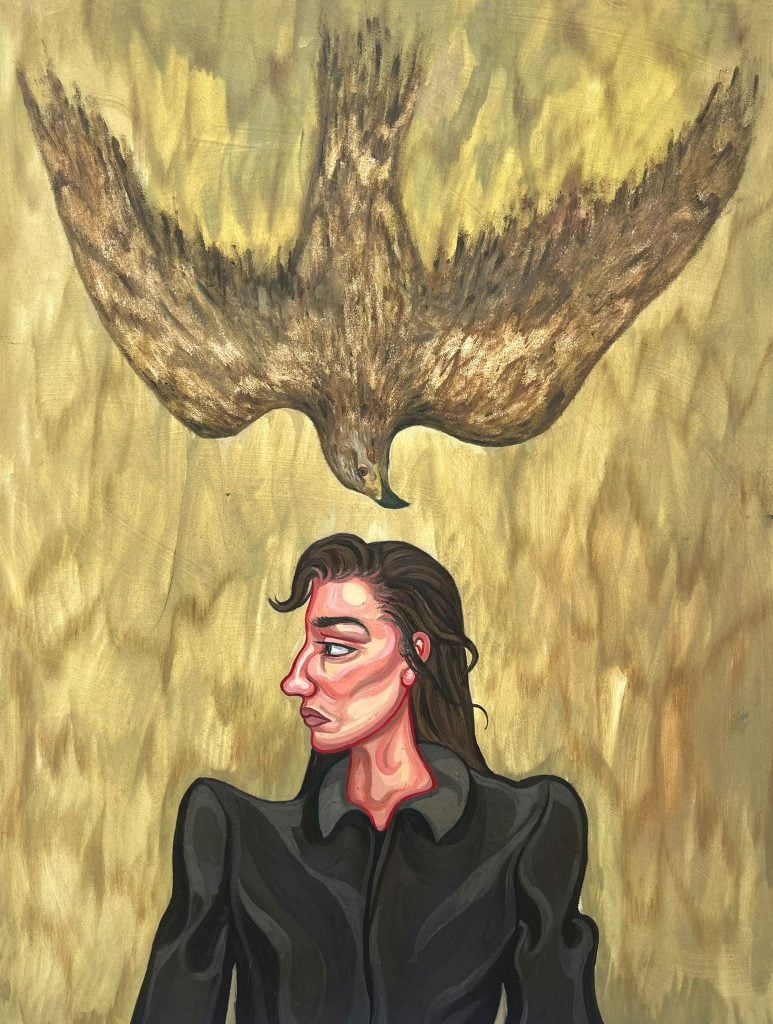Studio Visit
British Artist Ania Hobson Paints Cryptic Figurative Scenes at Her Studio on an Airbase Famous for a UFO Sighting
The artist’s second solo exhibition with Setareh Gallery, “Deep-rooted,” is on view in Berlin through October 21, 2023.

The artist’s second solo exhibition with Setareh Gallery, “Deep-rooted,” is on view in Berlin through October 21, 2023.

Katie White

Two-way mirrors. UFO sightings. Airfield diners. British artist Ania Hobson works in a studio housed in an old airbase that—regardless of its quirkier attributes—she treasures for its bright open space.

Ania Hobson at work in her studio, 2023. Courtesy of the artist.
There, Hobson (b. 1990) paints her psychologically powerful figurative scenes, characterized by their at-once cartoonish and emotionally raw gesturalism. In one recent painting, a listless-looking woman sits alone in a bar, thumbing her drink in an image that conjures up visions of both Degas’s and Picasso’s interpretations of The Absinthe Drinker. In another, three women walk together into empty sprawling hills in different shades of green.
Currently, Hobson’s works are on view in “Deep-rooted,” her second solo exhibition with Setareh Gallery in Berlin (through October 21). In these newest paintings, Hobson has started experimenting with the textures of the canvases themselves—with thin layers of oil paint amid the thick, impastoed brushstrokes for which she is best known. Landscapes also play an important new role—forests appear as mysterious backdrops in which her forlorn characters mingle with fauna and flora with nearly dream-like cryptic symbolism.
Coinciding with the exhibition, we recently spoke with the artist at her studio, where she told us about taking time to reintroduce herself to her work each morning, her passion for Edvard Munch, and having her meals at an Air Force diner.
Tell us about your studio. Where is it, how did you find it, what kind of space is it, etc.?
My studio is based on an old American airbase [in Suffolk, England] that was famous for its UFO sighting back in 1980. I have been in this studio for six years. I love my space—it’s open, light, and quite spacious with natural lighting dropping from the ceiling, which is exactly what I need as a painter. The space has a warm, relaxed feel, bearing in mind it’s the old interrogation space, with a two-way mirror.
How many hours do you typically spend in the studio, what time of day do you feel most productive, and what activities fill the majority of that time?
I usually arrive at my studio at 9:30 in the morning and stay until 6 or 7 p.m. at night. When I’m working on a deadline I will try to stay longer. The morning is my most productive. I start by having my breakfast and coffee in the studio and then I spend quite a bit of time sitting and looking at my work. I used to hate this as I felt I wasted a lot of time (I was probably just waking up). But I find that actually it’s really important to absorb the painting again, to reintroduce myself each time to the work. We spend so much time working with our heads close up to the canvas that it’s good to step back and breathe in the work from a distance and to mentally prepare before continuing. I never want to dive into a painting until I feel ready.
What is a studio task on your agenda this week that you are most looking forward to?
I’m looking forward to pre-mixing my skin tone paints and putting them into empty tubes. I find it a really laborious but satisfying process. I look forward to it because I know it saves me time in the long run when I’m working on a painting as most of the morning can be spent mixing all my skin tone paints. So it’s a nice thought that I can squeeze all the tones straight out onto the palette.
What are you working on right now?
I’m not working on anything at the moment. Both of my studios are empty as I’ve just finished painting for my Berlin show. When I get back to the studio I will be continuing with the theme that I have been working on, which is looking at the interconnectivity between humans and nature, and how it changes our emotions and behavior and evolutionary psychology. But for now, I’m enjoying my surroundings and taking a break from the studio.

Installation view “Ania Hobson: Deep-rooted,” 2023. Courtesy of the artist and Setareh, Berlin.
What tool or art supply do you enjoy working with the most, and why?
My paint tube squeezer! It’s one of my most used tools, I feel like I’m getting every last bit of paint out, paint is expensive stuff and I want to use every last drop of it.
What kind of atmosphere do you prefer when you work? Is there anything you like to listen to/watch/read/look at etc. while in the studio for inspiration or as ambient culture?
It can really vary. Sometimes it has to be a calm, relaxed atmosphere, or I can put on podcasts ranging from history or climate to murder mysteries. If I’m feeling too traumatized from the murder mysteries, I put on instrumental music with no lyrics. I’m quite controlled when it comes to my working environment. I can’t be distracted too many times as it completely throws me off and I find it very hard to get back into the rhythm of things, so when I’m painting it really is ‘do not disturb.’
How do you know when an artwork you are working on is clicking? How do you know when an artwork you are working on is a dud?
I know a painting is working when I’m eager to get back to the studio to finish it or to start it. I get excited when I have a good idea and painting usually flows. I know it’s failing when the love has gone. That’s when I notice that I start working on it longer than usual and I feel it taking away my energy, which isn’t being transcended into the painting itself. If I’m not feeling it, I tend to just leave the painting. I never fight through it.
When you feel stuck while preparing for a show, what do you do to get unstuck?
I think what I’ve learned is that I haven’t given myself enough time for ideas or I agreed to more paintings than I can produce. It’s all about what makes you comfortable and your work style. A lot of gallerists are not artists. Galleries are a business and you have to remember that what you produce is from your head, heart, and hand. It takes a lot of energy and time to make something special that you’re happy with. Our paintings should be truthful and reflect the true versions of us and not a state of panic. When I’ve felt stuck I usually give myself a day off, draw, listen to music, and just live life, which is where a lot of my inspiration is from. I find it helps motivate me to bring me back to feeling excited about what I’m making.

Ania Hobson, The Freedom You Have Is What I’ve Always Wanted (2023). Courtesy of the artist and Setareh, Berlin.
What images or objects do you look at while you work?
All of my paintings are from my imagination which is just part of my subconscious, my experiences, sights, sounds, and smells, it’s all about creating atmospheres and working with my own anxieties and emotions. It’s like a third vision that’s been through my eyes, brain, and canvas—it’s less forgiving and I prefer that.
What’s the last museum exhibition or gallery show you saw that really affected you and why?
I went to see the Edvard Munch exhibition in Berlin. I’ve always loved his figures in landscapes, some of them are really dark, but I find them the most moving. It was really comforting to see how a commission changed his style. It was interesting to see how it made it more constricted and less fluid. I used to do commissions. I found I struggled with them so it was good to see this in another painter. It really shows that we paint for ourselves.
Where do you get your food from, or what do you eat when you get hungry in the studio?
I get my food from the diner on the air base. It does great affordable food! It’s my go-to as painting definitely builds up an appetite. I usually go for one of their salads or a jacket potato, which I find lasts me for the rest of the day.
What’s the last thing you do before you leave the studio at the end of the day (besides turning off the lights)?
I look at my paintings like a mom would in a film, gazing at her sleeping children before switching the lights off.